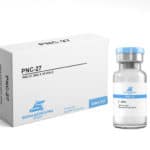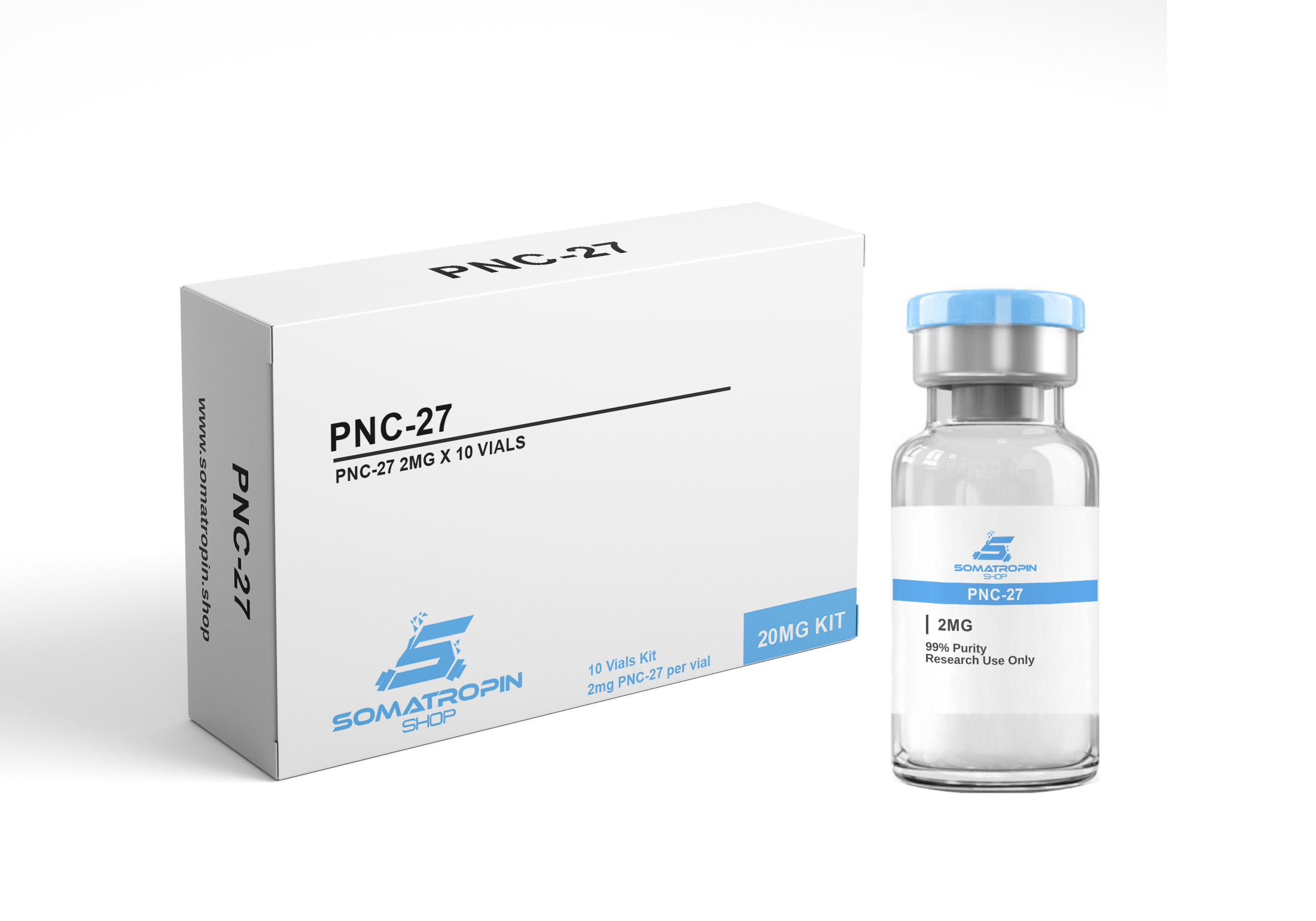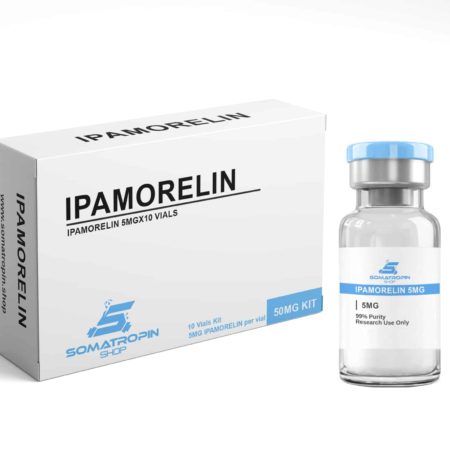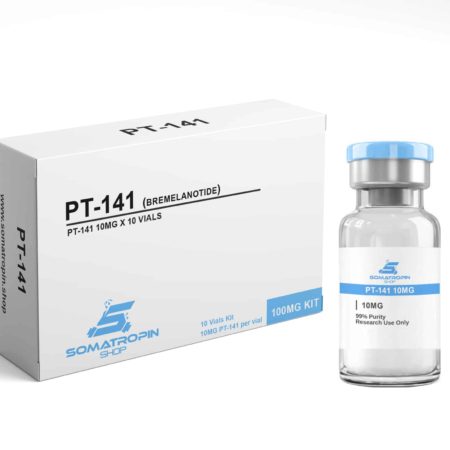What is PNC-27?
PNC-27 is a synthetically created peptide designed to target and destroy cancer cells. It is a member of the PNC set of investigational Proteins designed to attach to Malformed (Cancerous) cells and cause them to die through Cell Necrosis while leaving normal, healthy cells intact and unharmed.
The PNC-27 peptide contains an HDM-2 binding domain corresponding to residues 12-26 of p53 and a Transmembrane-Penetrating domain.
Through research and study on animal subjects, the PNC-27 peptide is highly effective in selectively targeting a wide variety of specific forms of cancer, including Pancreatic cancer, breast cancer, Leukemia, Melanoma, and additional cancer lines.
PNC-27 Peptide
Molecular formula: C188H293N53O44S
Molar Mass: 4031.7
How Does the PNC-27 Peptide Work?
PNC Proteins were first theorized and created in 2000 by Drs. Matthew Pincus and Joseph Michl at the SUNY Downstate Medical Center in New York. Although they were initially intended to combat HIV, PNC-27 showed a remarkable ability to bind to cancer cells, causing them to die while leaving healthy cells undamaged.
The PNC-27 cancer peptide is a Nontoxic compound that causes the death of Cancer Cells only, leaving all other healthy cells unaffected. It can do this by attaching to the Membranes of the individual cancer cells, creating holes in those Membranes. As a result of the gaps, rapid implosion occurs, leading to swift cell death due to the osmotic pressure difference in the inside vs. outside Tumor Cells.
PNC-27 accomplishes this due to its affinity for binding to a protein called HDM-2. Cancer cells have HDM-2 in their cell Membranes. When the PNC-27 peptide is administered, it immediately travels to the HDM-2 located in the Membranes of Cancerous cells. Binding to them creates pores or holes in the Cell Membrane, causing “Membranolytic,” or death of the cell Membrane. This process, in turn, leads to the destruction of the cancer cell.
Clinical Studies of the PNC-27 Peptide
In a paper published by the American Association for Cancer Research in 2010. Drs. Ehsan Sarafraz-Yazdi et al. revealed in depth how the PNC-27 cancer peptide exerted its effects and what its novel mechanism of action meant for cancer research. The paper’s authors reported that the peptide’s mechanism of action is due to the formation of Oligomeric pores in the Plasma Membrane of Tumor Cells. Concurrently, Oligomeric pores are not formed in untransformed or Non-tumor cells. Further, they noted that Research had shown that MDM2 as a targeting molecule leads to PNC-27 selectivity towards cancer cells by its Mis-localization to cancer cell plasma membranes.
Researchers concluded that these findings are descriptive of the unique localization of MDM2 variants in the plasma membranes of Cancerous cells. Further, they stated that this knowledge might hint at great promise for the PNC-27 peptide as a future Anti-cancer drug pending clinical trials.
The PNC-27 research peptide has been the subject of a fascinating Ted Talk. It can be seen conducted by Dr. Sarafraz-Yazdi, an Assistant Professor in the Division of Gynecologic Oncology at The State University of New York (SUNY).
PNC-27 Peptide Reviews
When the PNC-27 peptide is administered in animal studies, certain aspects have been noted in successful outcomes. Researchers have pointed out that pain levels subjectively drop in a mean time of about a week. By the three-week mark, animal subjects often present with Flu-like symptoms, a likely indicator that subjects’ immune systems are responding to the death of cancer cells.
At six weeks, Lactate Dehydrogenase and Bilirubin levels typically increase. Substantial tumor breakdown in successful research outcomes is often observed at around the ten week mark. At this time, the tumors are noted to become softer and more pliable.
Some increase in the tumor size may be noted at this time. However, this is often due to inflammation because of the Immune System response. By the end of 3 months, researchers often notice animal study subjects exhibit increased energy levels and reduced Cancer-related symptoms.
PNC-27 Side Effects in Studies
PNC-27 side effects have been observed in animal studies. These have included skin and nose inflammation, watery eyes, dry skin, high blood pressure, headache, back pain, nosebleed, rectal bleeding, taste change, and too much protein in the urine.
PNC-27 Clinical Trials
In a 2009 study, Researchers found that the previously established three-dimensional structure of PNC-27’s p53 residues was directly superimposable on the structure for the identical residues bound to HDM-2. This study led the Researchers to infer that PNC-27 could target HDM-2 in cancer cells’ membranes.
Cancer cells have significant levels of HDM-2 in their membranes, while untransformed or Noncancerous cells do not have significant levels of HDM-2. This allows the PNC-27 peptide to selectively target the Cancerous cells, leaving the healthy surrounding tissue undamaged.
Upon further experimentation, Scientists discovered that by implanting untransformed cells not susceptible to PNC-27 with HDM-2 containing a membrane localization signal, these cells became sensitive to PNC-27. As a result, this constituted further evidence that the PNC-27 peptide could selectively target HDM-2 in the membranes of cancer cells and destroy them via Membranolysis, all while leaving healthy cells unharmed.
Further, in a 2010 study published in Cancer Chemotherapy and Pharmacology, researchers determined that PNC-27 exerts its cancer Cell-destroying effects as a whole peptide, not fragments. With the knowledge that the peptide forms transmembrane pores in the cancer cell membrane, researchers determined whether these pores were created by parts of the peptide (fragments) or the entire peptide itself.
During the experiment, Researches showed that it was indeed the entire peptide that exerts its effects in the cell membrane of cancer cells. Further, Cells observed that other nontransformed, or Noncancerous, cells around the cancer cells “remained viable.” From the experiment results, researchers gleaned that the PNC-27 cancer peptide targeted specific markers in the membranes of cancer cells. Also, via this mechanism of action, PNC-27’s lifetime is increased.
PNC-27 Peptide Destroys Cancer Cells
In a 2006 study published in the International Journal of Cancer, Researchers found that PNC-28, a Forerunner to the PNC-27 peptide very similar in its structure and effects, was able to inhibit Pancreatic cancer cell growth in Vivo selectively. Study observers noted the Peptide-induced Necrosis, but not Apoptosis, in various tumor cell lines, including the Ras-transformed rat Acinar Pancreatic Carcinoma cell line known as BMRPA1. In addition, the peptide did not affect untransformed (normal) cells. As a result, Researchers looked to determine if Cancer-killing peptides could block the growth of Pancreatic cancer cells in Vivo.
Amazingly, Researchers observed that when the cancer-killing peptide was administered, it caused a complete blockade of any tumor growth during its 2-week period of administration and two weeks Post-treatment. This process was followed by weak tumor growth that plateaued at small tumor sizes compared with tumor growth in the presence of a control peptide.
Further, when the Cancer-killing peptide PNC-27 was administered after tumor growth had occurred at a remote site from the tumor, a decrease in tumor size followed by a slow increase in tumor growth that was “significantly slower than growth in the presence of control peptide” was observed to occur. Consequently, the study researchers concluded that the Cancer-killing peptide might be effective in treating cancer, especially if administered directly to the tumor.
PNC-27 Anti-Cancer Peptide Studies
In a more recent study conducted in 2014 and published in the Annals of Clinical & Laboratory Science, researchers concluded that “the anti-cancer peptide, PNC-27, induces tumor cell necrosis of a poorly differentiated non-solid tissue mammalian leukemia cell line that depends on the expression of HDM-2 in the plasma membrane of these cells.”
Essentially, Researchers built on knowledge from earlier experimentation that the PNC-27 peptide could destroy solid tissue tumor cells by binding to HDM-2 Proteins in their cell Membranes, an effect independent of p53 activity in those cells. The scientists sought to determine whether the PNC-27 peptide would be similarly effective against Non-solid tissue tumor cells.
This experiment would determine whether such Non-solid tissue tumor cells expressed HDM-2 in their Membranes in the first place (as the solid tissue cells were found to) and see whether PNC-27 could induce cell death in these cells through the exact HDM-2 binding mechanism.
Incredibly, after observing that these Non-solid tumor cells express HDM-2 in cell membranes. Also, Researches found that the PNC-27 peptide could induce cell necrosis through Membranolysis via the same HDM-2 binding mechanism as in solid tissue tumor cells, independent of the P53 pathway.
| Dosage | 20mg (2mg x 10 Vials), 50mg (5mg x 10 Vials) |
|---|
Related Products
PEGylated Mechano-Growth Factor is a modified form of MGF, itself a modified form of IGF-1. Research has shown it to lower cholesterol and total body fat, boost immune function, and improve rates of wound healing.
All Peptides are shipped non labeled
IGF-1 DES is a truncated, natural version (splice variant) of insulin-like growth factor-1. Naturally found in the brain, breast milk, and uterine tissue, IGF-1 DES stimulates hypertrophy and hyperplasia of a number of different cell lines. Research has shown this version of the protein to be more potent than standard IGF-1, mostly as a result of its enhanced bioavailability. Currently, researchers are looking at ways to utilize IGF-1 DES in the treatment of inflammatory bowel disease (IBD), autism, and a variety of neurological conditions. Research shows that it helps to maintain the health of synaptic connections in the central nervous system and, like all IGF-1, promotes the repair of muscle and connective tissue.
10mg Kit
1mg X 10 Vials
All Peptides are shipped non labeled
All Peptides are shipped non labeled
Ipamorelin is a pentapeptide, meaning that its structure is comprised of five amino acids. It is a secretagogue, and is considered to be an agonist, meaning that it possesses the ability to bind certain receptors of a cell and provokes a cellular response. Ipamorelin’s operational mechanics enables the peptide to stimulate the production of pituitary gland-based expression of secretions related to growth amongst animal test subjects. At the same time, the presence of the peptide has been shown to inhibit the production of a secretion known as somatostatin. Additionally, it has been determined that Ipamorelin has the ability to boost the production of IGF-1, or Insulin-like Growth Factor 1. Its presence plays a key role in the overall growth and repair of muscular and skeletal tissue.
All Peptides are shipped non labeled
CJC-1295 No DAC is a truncated peptide analogue of growth hormone releasing hormone (GHRH). First developed in the 1980s, research studies with modGRF have shown it to improve muscle repair and growth, accelerate wound healing, strengthen bones, increase fat burning, and improve metabolism. It may also have beneficial effects on blood sugar regulation and the immune system.
All Peptides are shipped non labeled
20mg Kit
2mg X 10 Vials
All Peptides are shipped non labeled
PT-141, also called Bremelanotide (generic clinical name), is a heavily modified synthetic derivative of alpha-melanocyte-stimulating hormone. It has been tested in clinical trials as a treatment for both male/female hypoactive sexual desire disorder and acute hemorrhage. PT-141 is an agonist for the melanocortin-4 and melanocortin-1 receptors. Research shows that it promotes sexual arousal and stimulates the immune system.
All Peptides are shipped non labeled
Gonadorelin is a gonadotropin releasing hormone agonist that has shown benefit in the treatment of infertility and hypogonadism. Recent research suggests that gonadorelin may be useful in slowing the growth of breast and prostate cancer. Studies also show promise in the treatment of Alzheimer’s disease.
20mg Kit
2mg X 10 Vials
All Peptides are shipped non labeled
All Peptides are shipped non labeled
Selank is a short, synthetic analogue of tuftsin.
It has profound anti-anxiety properties.
Selank also boosts memory and learning and has been shown to have beneficial effects on pain perception
All Peptides are shipped non labeled
Melanotan (MT-1) It is used clinically, to prevent sun-related skin damage (i.e. phototoxicity) from occurring in people suffering from erythropoietic protoporphyria. Though initially developed as a sunless tanning agent, melanotan 1 has been found to have a number of physiologic effects on blood pressure, feeding behavior, central nervous system function, and more.
100mg Kit
10mg X 10 Vials
All Peptides are shipped non labeled
Categories
Tags
- 100iu
- anti aging
- anti wrinkles
- bioregulator
- bioregulators
- Bodybuilding
- cjc
- cjc 1295
- cjc1295
- cycle
- fat loss
- genotropin
- gh
- ghrp
- gnrh
- hgh
- human growth
- human growth hormone
- hygetropin
- igf
- igf-1
- ipamorelin
- jenotropin
- kingotropin
- kit
- mgf
- nordictropin
- norditropin
- orals
- pct
- peptide
- peptides
- primo
- Primobolan
- roids
- selank
- semaglutide
- somatropin
- Stanozolol
- steroid
- steroids
- Tesamorelin
- testosterone
- Tirzepatide
- Winstrol















